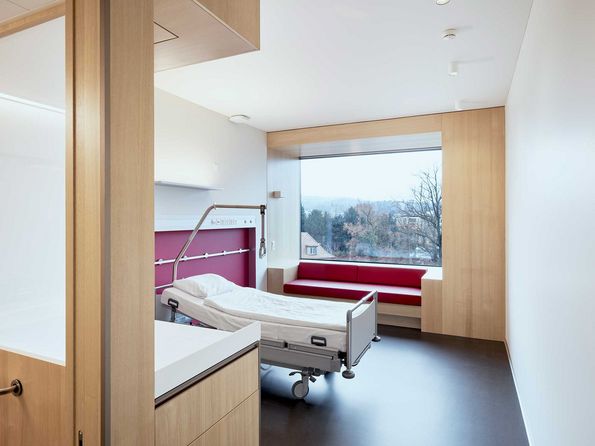Veneer at KSW Winterthur
Getting healthy with wood
Roser veneers are used even more concretely in health care in the new extension of the Winterthur Cantonal Hospital. After more than ten years of project planning and construction, the new ward block has been open since February. The general planners from Rapp Architects made sure that almost all rooms have large windows facing south towards the park. In addition, the patient rooms were all designed with real veneer. "We are convinced that the atmosphere of the immediate surroundings has an influence on our well-being and recovery progress," says Thomas Stegmeier, overall head of projects at Rapp Architekten AG. With this inner conviction, together with Butscher Architekten AG, they created the responsible planning for the patient rooms as well. In addition to the aesthetic aspects, the rooms also had to reflect the needs of the nursing staff and the staff. "The natural beauty of wood appeals to people, is familiar to us and connects us with the beauty of nature," says Stegmeier.
Many logs required
The planners decided on two types of wood, also to architecturally differentiate the insurance classes. However, it was important that in both cases the wood was native. Chestnut in its rather calm, honey-coloured basic tone with the monolithic, dark flooring creates a very harmonious whole. European walnut is quite different, with its strongly changing colour nuances from light to very dark and its extremely lively, characterful expression. "Walnut is interpreted as a noble, rather luxurious material. A circumstance that we wanted to use consciously," explains Stegmeier.
In the end, 4500 m2 of walnut and 6500 m2 of chestnut veneer were needed. "The biggest challenge was finding the amount of European walnut. The decisive factor here is the length. 2800 millimetres of finished dimensions of the workpieces require 2900 millimetres of crack-free veneer as the starting material plus an extra charge for the trunk wood. Since European walnut often has a large, light sapwood content, great attention had to be paid to the distribution of sapwood and heartwood.
A big thing with high standards
It was easier to deal with the chestnut, which was to be plain throughout and, like the walnut, was also joined with a board character. In the end, six articulated lorries with material went to the five carpentry workshops involved. "Depending on the application and placement in the building, Roser delivered not only raw veneer but also joined fixed mass and veneered boards on different carrier materials to the companies.
The effort was obviously worthwhile. "The feedback we receive from patients and staff is extremely positive, even enthusiastic," says Stegmeier. Of course, this has not only to do with the wood, but it plays its part.

